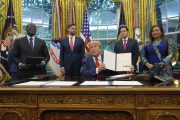
Over 1,000 people turned up to listen to former Alaska Governor Sarah Palin deliver the keynote address at the first annual Tea Party Convention. Much has been written about Palin’s speech and the crib notes scribbled on her palm, but in between the lines of her rally cry, there was much more than meets the palm.
First, Sarah Palin is no conservative; she is a neo-conservative. In Greek, the prefix “neo-“ translates as “new,” but in the case of Sarah Palin and her ilk, it translates as “not.” In an interview with Fox News’s Chris Wallace, Palin slinked out of her “Tea Party” mask and revealed the warmongering neo-con underneath. “Say he [President Obama] decided to declare war on Iran … which I would like him to do,” Palin responded to a question about her opinion of ways President Obama could improve his chances for reelection in 2012.
True conservatives are constitutionalists and, as such, they know that no President, including President Palin, can declare war; declaring war is the exclusive province of the Congress (see Article I, Section 8 of the Constitution). That’s the first problem with Palin’s remarks.
Second, non-prefixed conservatives are opposed to the use of our armed forces as a bootstrap for empire. America is a Republic and the elected representatives of the people have no authority to spend the blood and treasure of Americans in furtherance of a Pax Americana, not in Iraq, not in Afghanistan, and certainly not in Iran. Conservatives decry the use of American armed forces in neither the exporting of “democracy” (which is not, incidentally, the type of government established by our Constitution) nor the toppling of regimes.
Third, constitutionalists have one principal aim: re-shackle a runaway government by restoring adherence to the timeless principles of our sacred Constitution. Conservatives demonstrate true patriotism when they demand that their leaders conform in all matters to the constitutional barriers placed around their spheres of power. No personality, regardless of appeal or appearance, should detract committed constitutionalists from their zealous retrenchment of a government that has careened wildly off the rails.
Apart from the keynote discourse delivered by Sarah Palin, there was much to praise about the Tea Party Convention — such as the determination and spirit of the attendees. Overlooking some standard “Central Casting” coterie of circa-1776 attired convention-goers with tri-cornered hats and buckled shoes, for the most part, the attendees were serious about this movement (serious enough to have forked over the nearly $600 for an all-access pass) and were determined to get down to the shoulder-to-the-wheel, nose-to-the-grindstone business of solidifying this often disparate confederacy into a union of powerful politically savvy grass-roots activists eager and able enough to help elect a slate of constitutionally minded candidates from Maine to California.
There is an ample slate of constitutional candidates up for election and the workaday grind of getting them elected is the long row that must be hoed by the army of volunteers toiling under the banner of the Tea Party. The immediate goal is electing committed conservatives to Congress in 2010 and a putting a conservative in the White House in 2012. Several key races were singled out by presenters at the convention, including some 50 seats in the House of Representatives from Alabama to Oregon. There is the fight for Alabama’s Second District, considered a toss-up by campaign bookmakers. The district is overwhelmingly socially conservative, but with a significant African-American population that is historically Democratic. Florida’s Eighth District is in the sights of Tea Party campaigners, as well. This district is home to an older demographic that dislikes big government, but may be reluctant to support spending cuts to entitlements for the elderly.
Wherever they deploy their resources, the movement’s members will learn that wielding the two-edged sword of influence is a skill that must be mastered. Fortunately, there was no shortage of tutors on the convention floor. Judson Phillips, founder of the Tea Party Nation (a sort of “Facebook” for Tea Partiers and the principal sponsor of the event), commented that he envisioned the convention to be less confetti and balloons and more “Electioneering 101.” “What we want people to do is to leave here connected with other activists so they can recruit good candidates, get candidates exposed to the voters and get voters to the polls,” he said. He realizes, as do most of those who gathered at the inaugural meeting in Nashville, that signs, placards, and self-congratulating speeches don’t win elections.
Although Phillips and his organization sponsored the convention, he certainly is not the leader of the Tea Party. As a matter of fact, this movement is defiantly, proudly egalitarian and resistant to any assertion of central leadership. Attendees refused to either identify or defer to spokesmen or leaders. In fact, almost to a man they adamantly reject the notion that such a hand on the helm is necessary and certainly not desirable. There is an independent streak a mile wide in the Tea Party palette.
Among the booths populating the convention floor at the Gaylord Opryland Hotel in Nashville, there were many of the usual suspects of the conservative wing: Young Americans for Freedom and Judicial Watch. There were representatives of WorldNetDaily (a web-based conservative news repository) handing out brochures encouraging the nationwide erection of billboards asking the question, “Where is the birth certificate?” (a reference to the “birther” controversy, which asserts with some validity that there is evidence showing that President Obama was not born in the United States). One of the advocates of the “birther” branch of the movement, Joseph Farrah, delivered a speech denouncing President Obama as a usurper and humorously adding that the birth of Jesus Christ was better documented than the birth of President Obama.
There were other so-called “fringe” groups participating in the confab. Judge Roy Moore of Alabama (the judge who refused to remove a monument to the Ten Commandments from outside his courthouse) spoke to the crowd and warned of growing UN influence over the foreign policy of the United States. One night the convention-goers were treated to a screening of the movie, Generation Zero, a celluloid condemnation of the maniacal manipulation of the economic system by elitist establishment financiers and finaglers conspiring to vitiate the economic might of the United States through cycle after cycle of manufactured fiscal meltdowns.
The presence of the more right-wing, conspiracy-wary elements of the conservative ideology prompted one writer to describe the Tea Party movement as “more John Birch than John Adams” and “dangerously detached from reality.” Although certainly intending insult to the Tea Party and the John Birch Society, the Newsweek journalist who wrote that description was being too clever by half. If the Tea Party movement were to adopt the constitutionally sound principles espoused by the John Birch Society and cleave consistently to that founding document then perhaps the entire country joyfully could escape from a reality haunted by big-government, redistributive, collectivist socialism and return to a Republic dedicated to the restriction of government to the limited, enumerated powers set forth in the Constitution.
Now that the lights are out and the banners have been removed from the banisters, the rank and file (and, as mentioned above, it’s all rank and file) have moved on from Nashville and are preparing themselves for the 2010 showdown. For its part, Tea Party Nation has extended an invitation to the leadership of both major parties to speak at town-hall meetings it has planned for this year. Conservatives within and without of the Tea Party umbrella view the Republicans and Democrats as co-conspirators and judge them equally culpable for the expansion of government and the crippling of the middle class. Not surprisingly, Judson Phillips reports that the chairmen of both parties have declined his invitation, proving once again that Potomac Fever is no respecter of party.
One prominent plank of the Tea Party platform that is being erected is the “Contract From America.” This idea is the brainchild of Ryan Heckler, convention attendee and long-time conservative activist. According to Heckler, the “Contract From America” will be a contract between America and its elected representatives holding the latter accountable to the former for every action taken on their behalf. “You are going to be held accountable by us,” says Heckler. “We have a plan — a proactive reform plan — for you to follow and not the other way around,” he continued.
Heckler plans to present the plan to the public on Tax Day, April 15, 2010. Between now and then, he will open the contract up to suggestions submitted to the website contractfromamerica.com. After the window for submissions closes, Heckler will whittle the platform down to 10 or 12 popular planks.
In order to avoid internecine scrimmages, Heckler intends to restrict the contract’s clauses to economic and government reform measures. “Our movement is free markets, constitutionally limited government, and economic freedom,” Heckler remarked. He admitted that the limitations on the scope may displease some, particularly the socially minded conservative element so prevalent in the Tea Party mix, but the omission is designed to prevent fissures and unite rather than divide.
There is room enough in the pot for all the varied ingredients in the conservative stew. If the genuine aim of the movement is to require constitutional conformity by those we have elected to represent us in Congress, then all eyes must be focused intently on that prize. There is work to be done in every district, in every state of the Union and every additional pair of hands is welcome and wanted. The Tea Party movement does not have a monopoly on conservatism, however, and in truth that conglomeration does not represent the universe of constitutionalist thought. That’s OK, though. We needn’t hamstring the effort to restore adherence to Constitutional principles by rigidly insisting that all those pitching in wear the same uniform. What is mandatory, however, is that all those zealous for the restoration of the Republic rally around the banner crafted in Philadelphia in 1787 and steadfastly demand that our leaders affirm their resolve to be hedged in by the limited, restrained, enumerated powers set forth therein.




